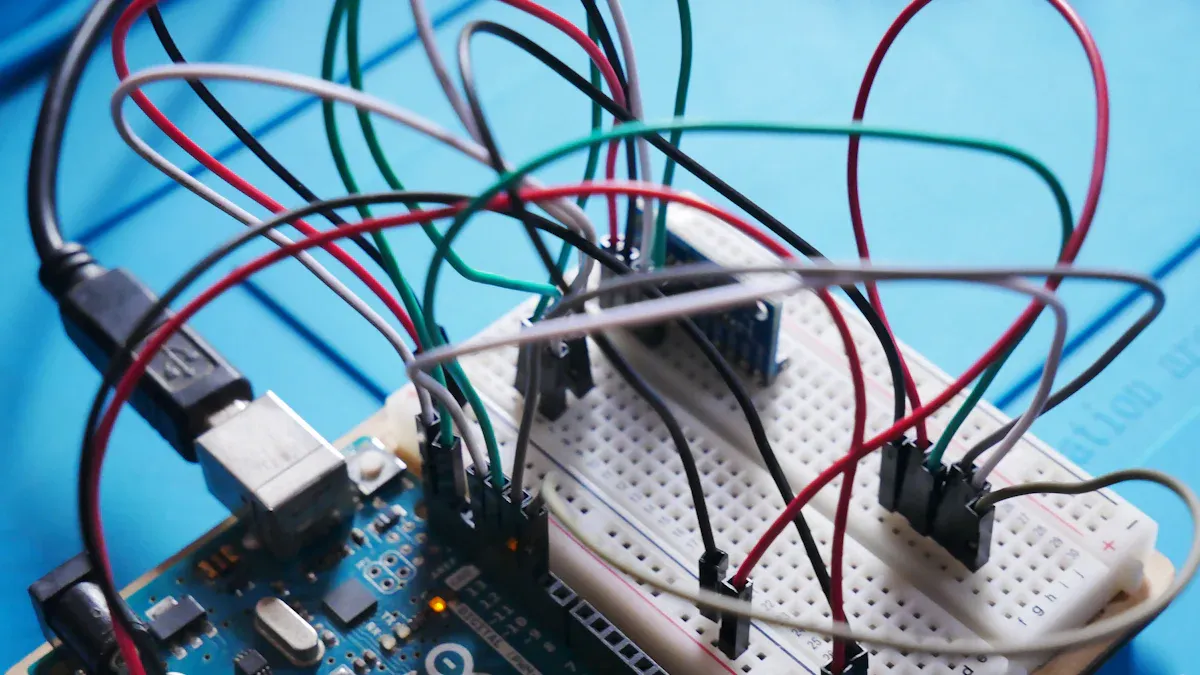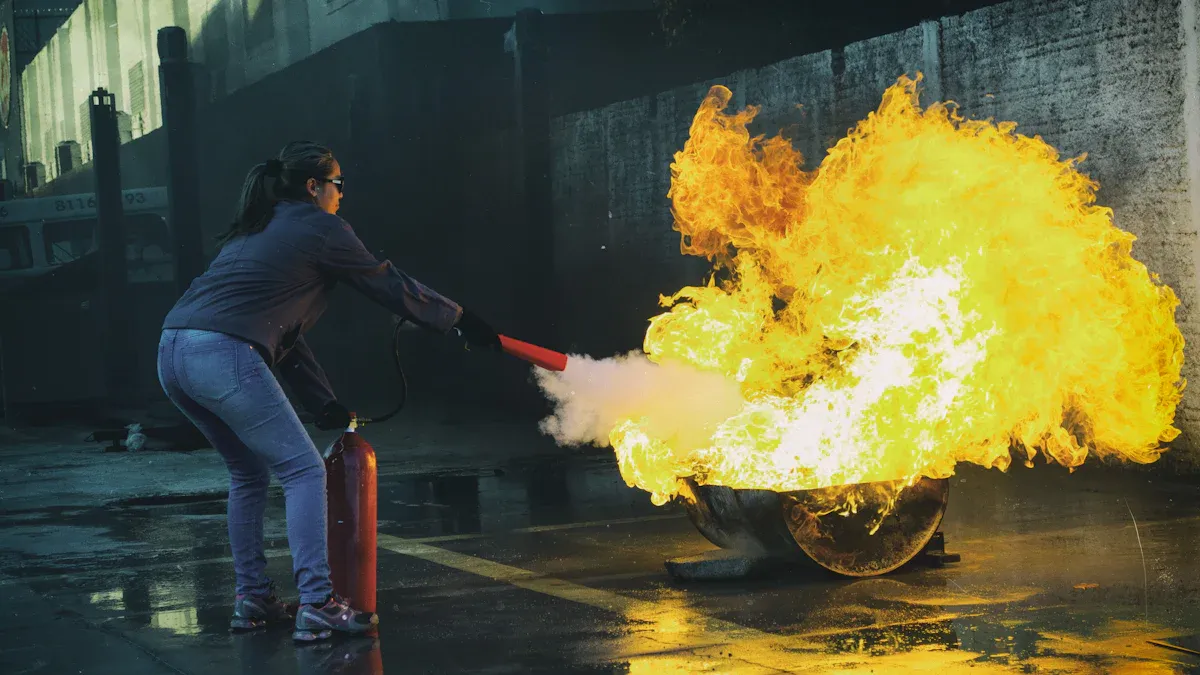
The most critical industrial robot battery failure incidents stem from battery thermal runaway, improper charging, and physical damage. These failures are costly; industrial mobile robots experience a 10% downtime from battery faults alone.
However, teams can manage this failure risk. A focus on industrial robot battery safety is key. Advanced battery management systems, strict protocols, and thermal management systems protect the battery. This commitment to industrial safety ensures the safety of the battery and industrial robots. Industrial safety for the battery is vital for all industrial robots, boosting industrial safety and battery life.
Primary Causes of Robot Battery Failure

Understanding the root causes of battery failures is the first step toward prevention. For industrial robots, these issues often trace back to thermal, electrical, and physical stressors. Proactive management of these factors is essential for operational safety.
The Threat of Overheating
Heat is a primary enemy of battery health and safety. High ambient temperatures in an industrial facility accelerate the chemical reactions inside a battery. This constant stress shortens the battery’s lifespan and elevates thermal runaway risks. A battery thermal runaway event can have severe consequences. The internal temperature of the battery rises uncontrollably, posing significant safety hazards. This process escalates quickly, as shown below.
| Event | Temperature (°C) | Consequence |
|---|---|---|
| Accelerated degradation | >40 | Reduced cycle life, capacity loss |
| SEI layer decomposition | 80 | Release of flammable hydrocarbons |
| Separator melt | 130 | Internal short circuit |
| Thermal runaway | ~150 | Venting gas, fire, or explosion |
These thermal runaway risks make temperature management critical for industrial safety. A battery thermal runaway is a serious industrial incident.
Improper Charging Cycles
Incorrect charging protocols cause significant battery damage and create safety risks. Using non-manufacturer-approved chargers is a major contributor to battery failures. These chargers can cause a battery to overheat, leading to fires and compromising workplace safety. The U.S. Consumer Product Safety Commission warns against this practice for all battery-powered devices, including industrial robots. Furthermore, allowing a battery to deep discharge frequently reduces its lifespan. A battery voltage dropping below 3.2V is a clear sign of poor health and impending failure. Proper charging is fundamental to battery safety.
Physical Damage and Environment
The demanding industrial environment exposes robots and their power sources to harm. Physical impacts are a direct cause of battery failure.
- Vibrations and mechanical shocks from normal operations can stress battery components.
- Corrosion from humidity or chemicals weakens terminals and internal structures.
- High humidity can create parasitic currents, leading to faster degradation and reduced safety.
These environmental factors accelerate wear and increase the likelihood of sudden failures in industrial robots. Protecting the battery from the physical environment is a key part of industrial safety.
Defects and Material Degradation
Sometimes, the cause of a battery failure originates inside the battery itself. Manufacturing defects, such as electrode misalignment, can create latent problems. Over time, microscopic lithium fibers called dendrites can grow inside the battery. These dendrites can pierce the separator, causing an internal short circuit. This event is a direct trigger for battery thermal runaway, a catastrophic failure that jeopardizes the safety of all nearby equipment and personnel. These internal degradation processes highlight the inherent thermal runaway risks in battery technology for industrial robots.
Proactive Solutions for Prevention and Safety
Operators can prevent most battery failures before they occur. A proactive strategy combines advanced technology, strict protocols, and diligent maintenance. These solutions create a robust framework for industrial robot battery safety, protecting assets and personnel. This focus on prevention is the most effective way to ensure operational reliability.
Advanced BMS Solutions
Modern battery packs for industrial robots contain sophisticated Battery Management Systems (BMS). These systems act as the brain of the battery, providing critical safety mechanisms and performance optimization. A BMS offers powerful solutions for prevention. It continuously monitors key parameters like voltage, current, and temperature. This constant oversight ensures the battery operates within safe limits.
An advanced BMS provides real-time feedback to the robot’s power system. This communication is crucial for correct charging and discharging processes. If the system detects a dangerous condition, it can disconnect the battery to prevent damage.
Effective battery management systems also extend battery life through a process called cell balancing. A battery pack contains many individual cells. Over time, these cells can develop different voltage levels.
- A cell balancing circuit maintains consistent voltage levels across all cells.
- This process prevents individual cells from becoming overcharged or undercharged.
- Equalized cells ensure the entire battery pack performs optimally and lasts longer.
These intelligent battery safety solutions are a primary defense against common failures and a key component of thermal runaway prevention.
Proper Operational Protocols
Technology alone cannot guarantee safety. Human operators must follow strict operational protocols. Proper training and procedures are essential for the prevention of battery incidents in any industrial setting. Teams must establish clear guidelines for battery handling, charging, and storage.
One of the most important rules is to always use the charger supplied with the robot. Manufacturer-approved chargers are designed to work with the battery’s specific chemistry and BMS. Using unapproved chargers can lead to overheating and create serious safety risks. Charging stations with UL Certification offer another layer of protection, as they include built-in safety mechanisms like over-voltage protection and thermal cutoffs.
Effective training is another pillar of industrial safety.
- Equipment-Specific Training: Every team member needs proficiency with their specific industrial robots. This includes understanding unique safety features and operational principles for quick error response.
- Emergency Protocols: Staff must know how to initiate an emergency shutdown. Rigorous practice helps stop the robot safely and minimize damage.
- Regular Safety Drills: Drills ensure that adherence to safety protocols becomes second nature, reinforcing a culture of prevention and safety.
These protocols are simple yet powerful solutions for maintaining a safe industrial environment.
Thermal Management Systems
Heat is a primary cause of battery degradation and failure. Thermal management systems are engineered solutions designed to control battery temperature, forming a critical part of thermal runaway prevention. These systems can be either active or passive, but both contribute to battery safety.
Active thermal management systems use energy to move heat away from the battery. These are common in high-power industrial robots where significant heat is generated.
- Fans: Small fans force air circulation around the battery or control boards.
- Peltier Coolers: These solid-state devices actively cool components when passive methods are insufficient.
- Flüssigkeitskühlung: An advanced solution for high-power robots that uses microchannel heat exchangers to significantly reduce temperatures.
Passive thermal management systems work without consuming power. They absorb and dissipate heat using clever material science. Heat sinks with Phase Change Materials (PCMs) are a great example.
PCMs absorb large amounts of thermal energy as they change from a solid to a liquid. This process occurs with very little temperature rise, keeping the battery within a safe operating range. This passive approach is an effective safety mechanism for thermal runaway prevention.
Both active and passive thermal management systems are vital battery safety solutions for modern industrial robots.
Routine Maintenance and Inspection
Preventive maintenance is the final piece of a comprehensive battery safety strategy. Regular inspections enable the early detection of potential problems before they lead to costly downtime or a safety incident. A consistent maintenance schedule is essential for all industrial equipment, especially the battery.
Operators should perform routine visual and diagnostic checks. Early detection systems and careful inspection provide the best chance for prevention. A thorough maintenance checklist helps ensure nothing is missed.
| Inspection Area | Was zu beachten ist |
|---|---|
| Visual Inspection | Swelling, dents, or leaks on battery cells. Frayed wires, loose connections, or corrosion on terminals. |
| BMS Check | Burned components, physical cracks, or error messages on indicator lights. |
| Overheating Signs | A burning odor, melted insulation, or components that feel unusually hot. |
| Diagnostic Check | Significant voltage differences between cells using a multimeter. High internal resistance readings from a specialized battery tester. |
This regular maintenance and detection process is fundamental to industrial safety. It ensures the battery remains in good health, extending its life and protecting the entire robotic system.
Responding to a Battery Failure

When a battery failure occurs, a swift and methodical response is crucial for industrial safety. A clear plan minimizes downtime and protects personnel from potential hazards. Following established procedures ensures that the situation is controlled safely and efficiently.
Immediate Emergency Actions
Immediate action is the first line of defense. The primary goal is to isolate the robot and its power source to ensure safety. Operators must follow strict Lock-Out Tag-Out procedures during any maintenance.
A standard procedure for industrial robots involves moving the robot away from any charging station, disconnecting chargers, and flipping the main circuit breaker to OFF. This ensures total power isolation for maximum safety.
Team communication is vital. Everyone should understand their role in the shutdown process. Securing the area prevents other personnel from entering a potentially hazardous zone. This focus on safety protects the team and the equipment.
Diagnosis and Troubleshooting
After securing the industrial robot, operators can begin to troubleshoot the issue. The robot’s teach pendant often provides the first clues. For example, some industrial robots display specific error codes, like C50A26, which points to a battery problem. This simple troubleshooting guide can help identify the source of the failure.
- Check the teach pendant display for any alarms or error messages.
- Power cycle the robot to see if the issue resolves.
- Attempt to clear any active alarms on the drive.
- If the robot does not power on, check that the battery is installed correctly and has been charged.
- Remove the battery and try to power the robot using only the main power switch to isolate the battery as the problem.
Safe Battery Replacement
Replacing a faulty battery requires careful handling and adherence to safety protocols. The old battery may be a fire or chemical hazard. Teams must use certified battery recycling services for disposal. These services provide documentation confirming proper recycling.
| Certification/Permit | Zweck |
|---|---|
| Responsible Recycling© (R2) | Ensures high standards for responsible battery recycling. |
| DOT Special Permits | Authorize special packaging for transporting damaged or defective batteries. |
Using these certified services is a key part of industrial safety and environmental responsibility. It ensures the old battery is handled correctly.
Restoring Operations and Calibration
A complete power loss from a battery failure has a critical consequence for industrial robots. The robot can lose its calibration and mastering values. This data loss means the robot forgets its origin position. Before restarting operations, an operator must reprogram this position. This process can be time-consuming and cause significant delays. Restoring the robot’s positional data is essential for it to perform its tasks accurately and safely. This final step ensures the industrial robots are ready for production without compromising safety or quality. These steps help manage battery failures effectively.
The most common industrial robot battery failures are preventable. A proactive strategy ensures industrial safety. This approach protects the industrial battery and industrial robots. It combines technology, strict protocols, and diligent industrial maintenance. This commitment to industrial robot battery safety guarantees uptime and extends battery life.
This focus on industrial safety and battery safety is essential. Proper industrial battery maintenance provides safety for all industrial robots. The industrial battery requires safety. This ensures total workplace safety and battery safety for all industrial robots.
FAQ
What is the first sign of a battery problem?
Operators often notice physical swelling of the battery case first. The robot’s teach pendant may also display specific error codes. These signs indicate an immediate need for inspection to ensure the battery is safe and functional.
How often should teams inspect an industrial robot battery?
Teams should perform quick visual checks daily before operation. A more thorough diagnostic inspection, including checking voltage and connections, should be part of a monthly preventive maintenance schedule. This routine helps catch issues early.
Can an industrial robot operate without a battery?
Some industrial robot models can run directly from the main power supply. This allows operators to test if a faulty battery is the source of a power issue. This step helps isolate the problem during troubleshooting.
Why is using the correct charger so important?
Manufacturer-approved chargers communicate with the battery’s management system. This prevents overcharging and overheating, which are major causes of failure. Using the wrong charger creates a significant safety risk and can damage the battery permanently.

